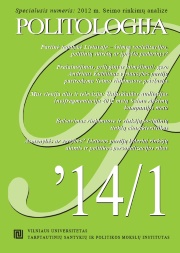PRALAIMĖJIMAS, PRILYGINTAS LAIMĖJIMUI: GERO ANDRIAUS KUBILIAUS VYRIAUSYBĖS PARTIJŲ PASIRODYMO SEIMO RINKIMUOSE PRIEŽASTYS
DEFEAT THAT WAS TREATED FOR VICTORY: REASONS BEHIND THE GOOD PERFORMANCE OF A. KUBILIUS’ GOVERNMENT PARTIES IN SEIMAS ELECTIONS
Author(s): Mažvydas JastramskisSubject(s): Politics / Political Sciences
Published by: Vilniaus universiteto leidykla & VU Tarptautinių santykių ir politikos mokslų institutas
Summary/Abstract: Scientific and non-scientific forecasts of 2012 Seimas elections were very unfavourable for the XV Lithuanian government head by Prime Minister Andrius Kubilius. Loss against all three opposition parties was predicted for the HU-LCD, dominant party of government. Both its junior partners, liberal parties LiCS and LRLM were expected not to exceed the legal threshold (5 percent of votes). However, despite the adverse circumstances governing coalition managed to perform very well in 2012 Seimas elections: according to the joint received vote share (25.71) it was the most successful government since the restoration of Lithuania’s independence. HU-LCD finished in second place according to parliamentary mandates, and LRLM even managed to improve its vote share if compared to the previous elections. This article aims to explain this defeat that for some politicians and observers appeared as victory: why the government of A. Kubilius performed so well (relatively, in the Lithuanian context) in Seimas elections? Two main theories are employed in the article. Party identification is theory centred about idea that voting behaviour is determined by stable psychological-emotional attachment to some party (party family) that is formed in the early socialization. In the Lithuanian context this theory is usually modified: majority of party identification traced to the excommunist-anticommunist cleavage (particularly prominent in early independence years, 1990–1992) and less rigid term “party attachment” is used. Existing research on subject reveals that HU-LCD has a stable core of voters, therefore it is expected for them to account for the most part of 2012 success. In the case of LRLM, since the party is very young (established in 2006), party attachment is supposed to work only if the rationalistic approach to party identification is also employed: that LRLM in the short life-span developed a reliable image and mobilized voters with liberal leaning attachment. According to these theoretical considerations, hypothesis is raised that electoral success of A. Kubilius’ government was mainly determined by party attachment factor. On other hand, party identification theory is not alone sufficient if loss of faithful voters and entrance of those without party attachment is considered. It is showed that despite overall unpopularity, A. Kubilius’ government enjoyed more positive evaluations than the XIV Lithuanian government of Gediminas Kirkilas. Moreover, economic situation in Lithuania improved the year before election. Therefore, economic voting theory is also employed: it asserts that voters make their decision on accounts of retrospective (prospective) evaluations of their own (egotropic voting) or country’s (sociotropic voting). It must be emphasized that this theory is completely compatible with the party identification theory, because it is able to explain shortterm losses and gains.
Journal: Politologija
- Issue Year: 2014
- Issue No: 1 (73)
- Page Range: 36-66
- Page Count: 31
- Language: Lithuanian

